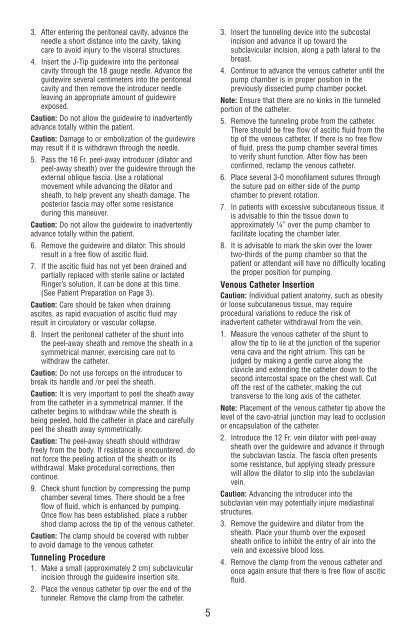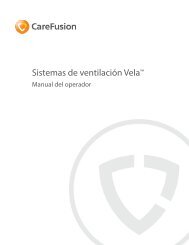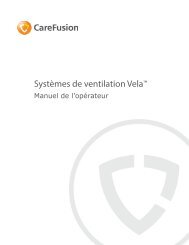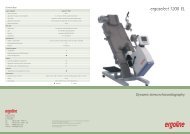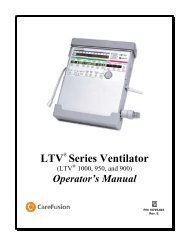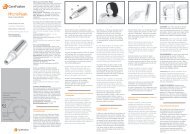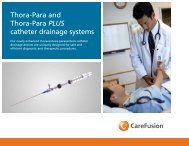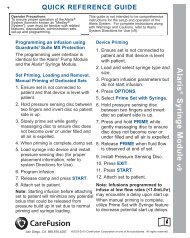Denver Ascites Shunt PAK 42-2050/42-2055 - CareFusion
Denver Ascites Shunt PAK 42-2050/42-2055 - CareFusion
Denver Ascites Shunt PAK 42-2050/42-2055 - CareFusion
You also want an ePaper? Increase the reach of your titles
YUMPU automatically turns print PDFs into web optimized ePapers that Google loves.
3. After entering the peritoneal cavity, advance the<br />
needle a short distance into the cavity, taking<br />
care to avoid injury to the visceral structures.<br />
4. Insert the J-Tip guidewire into the peritoneal<br />
cavity through the 18 gauge needle. Advance the<br />
guidewire several centimeters into the peritoneal<br />
cavity and then remove the introducer needle<br />
leaving an appropriate amount of guidewire<br />
exposed.<br />
Caution: Do not allow the guidewire to inadvertently<br />
advance totally within the patient.<br />
Caution: Damage to or embolization of the guidewire<br />
may result if it is withdrawn through the needle.<br />
5. Pass the 16 Fr. peel-away introducer (dilator and<br />
peel-away sheath) over the guidewire through the<br />
external oblique fascia. Use a rotational<br />
movement while advancing the dilator and<br />
sheath, to help prevent any sheath damage. The<br />
posterior fascia may offer some resistance<br />
during this maneuver.<br />
Caution: Do not allow the guidewire to inadvertently<br />
advance totally within the patient.<br />
6. Remove the guidewire and dilator. This should<br />
result in a free flow of ascitic fluid.<br />
7. If the ascitic fluid has not yet been drained and<br />
partially replaced with sterile saline or lactated<br />
Ringer’s solution, it can be done at this time.<br />
(See Patient Preparation on Page 3).<br />
Caution: Care should be taken when draining<br />
ascites, as rapid evacuation of ascitic fluid may<br />
result in circulatory or vascular collapse.<br />
8. Insert the peritoneal catheter of the shunt into<br />
the peel-away sheath and remove the sheath in a<br />
symmetrical manner, exercising care not to<br />
withdraw the catheter.<br />
Caution: Do not use forceps on the introducer to<br />
break its handle and /or peel the sheath.<br />
Caution: It is very important to peel the sheath away<br />
from the catheter in a symmetrical manner. If the<br />
catheter begins to withdraw while the sheath is<br />
being peeled, hold the catheter in place and carefully<br />
peel the sheath away symmetrically.<br />
Caution: The peel-away sheath should withdraw<br />
freely from the body. If resistance is encountered, do<br />
not force the peeling action of the sheath or its<br />
withdrawal. Make procedural corrections, then<br />
continue.<br />
9. Check shunt function by compressing the pump<br />
chamber several times. There should be a free<br />
flow of fluid, which is enhanced by pumping.<br />
Once flow has been established, place a rubber<br />
shod clamp across the tip of the venous catheter.<br />
Caution: The clamp should be covered with rubber<br />
to avoid damage to the venous catheter.<br />
Tunneling Procedure<br />
1. Make a small (approximately 2 cm) subclavicular<br />
incision through the guidewire insertion site.<br />
2. Place the venous catheter tip over the end of the<br />
tunneler. Remove the clamp from the catheter.<br />
5<br />
3. Insert the tunneling device into the subcostal<br />
incision and advance it up toward the<br />
subclavicular incision, along a path lateral to the<br />
breast.<br />
4. Continue to advance the venous catheter until the<br />
pump chamber is in proper position in the<br />
previously dissected pump chamber pocket.<br />
Note: Ensure that there are no kinks in the tunneled<br />
portion of the catheter.<br />
5. Remove the tunneling probe from the catheter.<br />
There should be free flow of ascitic fluid from the<br />
tip of the venous catheter. If there is no free flow<br />
of fluid, press the pump chamber several times<br />
to verify shunt function. After flow has been<br />
confirmed, reclamp the venous catheter.<br />
6. Place several 3-0 monofilament sutures through<br />
the suture pad on either side of the pump<br />
chamber to prevent rotation.<br />
7. In patients with excessive subcutaneous tissue, it<br />
is advisable to thin the tissue down to<br />
approximately ¼” over the pump chamber to<br />
facilitate locating the chamber later.<br />
8. It is advisable to mark the skin over the lower<br />
two-thirds of the pump chamber so that the<br />
patient or attendant will have no difficulty locating<br />
the proper position for pumping.<br />
Venous Catheter Insertion<br />
Caution: Individual patient anatomy, such as obesity<br />
or loose subcutaneous tissue, may require<br />
procedural variations to reduce the risk of<br />
inadvertent catheter withdrawal from the vein.<br />
1. Measure the venous catheter of the shunt to<br />
allow the tip to lie at the junction of the superior<br />
vena cava and the right atrium. This can be<br />
judged by making a gentle curve along the<br />
clavicle and extending the catheter down to the<br />
second intercostal space on the chest wall. Cut<br />
off the rest of the catheter, making the cut<br />
transverse to the long axis of the catheter.<br />
Note: Placement of the venous catheter tip above the<br />
level of the cavo-atrial junction may lead to occlusion<br />
or encapsulation of the catheter.<br />
2. Introduce the 12 Fr. vein dilator with peel-away<br />
sheath over the guidewire and advance it through<br />
the subclavian fascia. The fascia often presents<br />
some resistance, but applying steady pressure<br />
will allow the dilator to slip into the subclavian<br />
vein.<br />
Caution: Advancing the introducer into the<br />
subclavian vein may potentially injure mediastinal<br />
structures.<br />
3. Remove the guidewire and dilator from the<br />
sheath. Place your thumb over the exposed<br />
sheath orifice to inhibit the entry of air into the<br />
vein and excessive blood loss.<br />
4. Remove the clamp from the venous catheter and<br />
once again ensure that there is free flow of ascitic<br />
fluid.


